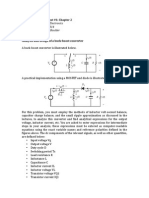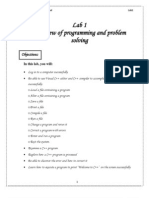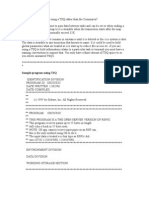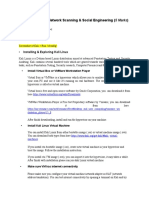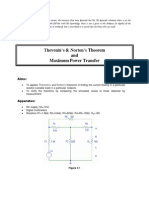OOP Lab Report 02
OOP Lab Report 02
Uploaded by
Saad RiazCopyright:
Available Formats
OOP Lab Report 02
OOP Lab Report 02
Uploaded by
Saad RiazCopyright
Available Formats
Share this document
Did you find this document useful?
Is this content inappropriate?
Copyright:
Available Formats
OOP Lab Report 02
OOP Lab Report 02
Uploaded by
Saad RiazCopyright:
Available Formats
Lab 02 – Classes and Data Abstraction
1. Objectives:
Objective of this lab is to understand the importance of classes and construction of objects
using classes.
2. Introduction:
The fundamental idea behind object-oriented languages is to combine into a single unit both data
and the functions that operate on that data. Such a unit is called an object. A class serves as a
plan, or blueprint. It specifies what data and what functions will be included in objects of that
class. An object is often called an “instance” of a class Syntax:
Classes are generally declared using the keyword class, with the following format:
Object Oriented Programming (CSC 241) Page 1
3.2 Data Abstraction:
Abstraction is the process of recognizing and focusing on important characteristics of a situation or
object and leaving/filtering out the un-wanted characteristics of that situation or object. For example a
person will be viewed differently by a doctor and an employer.
• A doctor sees the person as patient. Thus he is interested in name, height, weight, age, blood
group, previous or existing diseases etc of a person
• An employer sees a person as an employee. Therefore employer is interested in name, age,
health, degree of study, work experience etc of a person.
3.3 Member Functions and Variables:
Member variables represent the characteristics of the object and member functions represent the
behavior of the object. For example length & width are the member variables of class Rectangle and
set_values(int,int), area() are the member functions.
3.4 Constructors:
It is a special function that is automatically executed when an object of that class is created. It has no
return type and has the same name as that of the class. It is normally defined in classes to initialize data
members.
Syntax:
class_name( )
// Constructor body
Object Oriented Programming (CSC 241) Page 2
3.5 Destructors:
It is a special function that is automatically executed when an object of that class is destroyed. It has no
return type and has the same name as that of the class preceded by tild (~) character. Unlike
constructors, destructors cannot take arguments.
Syntax:
~ class_name ()
// Destructor body
3. In-Lab Tasks:
3.1. Task#01
Write a class that displays a simple message “I am object no. __”, on the screen
whenever an object of that class is created.
Code:
#include<iostream>
using namespace std;
class Alpha
public:
static int Count;
Alpha()
Count++;
Object Oriented Programming (CSC 241) Page 3
cout<<"\n\n\t I'm The Object
Numeber :"<<Count<<endl;
};
int Alpha::Count=0;
int main()
Alpha C1,C2,C3,C4,C5;
Output:
Object Oriented Programming (CSC 241) Page 4
3.2. Task#02
Write a program to calculate the number of objects created and destroyed for the counter
class.
Code:
#include<iostream>
using namespace std;
class Alpha
{
public:
static int Count;
static int Destruc;
Alpha()
{
Count++;
}
~Alpha()
{
Destruc++;
if(Destruc==Count)
{
cout<<"\n\n\t Total Objects
Created:"<<Count<<endl;
cout<<"\n\n\t Total Objects
Destroyed:"<<Destruc<<endl;
}
}
Object Oriented Programming (CSC 241) Page 5
};
int Alpha::Count=0;
int Alpha::Destruc=0;
int main()
{
Alpha C1,C2,C3,C4,C5,C6,C7;
}
Output:
Object Oriented Programming (CSC 241) Page 6
3.3. Task#03
Create a class that imitates part of the functionality of the basic data type ‘int’, call the
class Int. The only data in this class is an integer variable. Include member functions
to initialize an Int to 0, initialize it to an ‘int’ value, to display it, and to add two Int
values. Write a program that exercises this class by creating one uninitialized and two
initialized Int values, adding the two initialized Int values and placing the response in
uninitialized value and then displaying the result.
Code:
#include<iostream>
using namespace std;
class INT
{
private:
int Num;
public:
void Single_Zero()
{
Num=0;
}
void Single_Intger(int A)
{
Num=A;
}
void Display()
{
cout<<"\n\n\t Value Stored In A:
"<<Num;
}
void Sum(INT O4,INT O5)
{
Num=O4.Num+O5.Num;
}
};
int main()
{
INT O1,O2,O3;
O2.Single_Intger(15);
O3.Single_Intger(8);
Object Oriented Programming (CSC 241) Page 7
O1.Sum(O2,O3);
O1.Display();
}
Output:
1. Post-Lab Tasks:
1.1. Task#01
Create a class named time, the data members are hours, minutes and seconds. Write a
function to read the data members supplied by the user, write a function to display the
data members in standard (24) hour and also in (12) hour format.
Code:
#include <iostream>
using namespace std;
class Time
{
public:
int Hours;
int Mins;
int Secs;
Time()
{
cout<<"\n\n\t Please Enter The Hours: ";
cin>>Hours;
cout<<"\n\t Please Enter The Minutes: ";
cin>>Mins;
Object Oriented Programming (CSC 241) Page 8
cout<<"\n\t Please Enter The Seconds: ";
cin>>Secs;
void Display_24(int Hou, char Meri)
{
if(Meri=='P'|| Meri=='p' )
{
Hou=Hou+12;
}
else
{
if(Hou==12)
{
Hou=0;
}
}
cout<<"\n\n\t Time In Standered 24 Hour Format
is :\t "<<Hou<<" Hour : "<<Mins<<" Miuntes :
"<<Secs<<" Seconds";
}
void Display_12(char Meri)
{
cout<<"\n\n\t Time In Standered 12 Hour
Format is :\t "<<Hours<<" Hour : "<<Mins<<" Miuntes :
"<<Secs<<" Seconds "<<Meri<<"M";
}
};
int main()
{
Time Alpha;
char Meridiem;
int Format;
int H;
H=Alpha.Hours;
Object Oriented Programming (CSC 241) Page 9
cout<<"\n\t Meridiem System : \n\t (1) A:Am \n\t
(2) P:Pm \n\n\t Please Enter The Meridiem Keyword : ";
cin>>Meridiem;
Alpha.Display_12(Meridiem);
Alpha.Display_24(H,Meridiem) ;
}
Output:
Object Oriented Programming (CSC 241) Page 10
1.2. Task#03
Write a class marks with three data members to store three marks. Write three
member functions, set_marks() to input marks, sum() to calculate and return the sum
and avg() to calculate and return average marks. Write a program that exercises this
class by creating its objects and displaying results.
Code:
#include <iostream>
using namespace std;
class Student
{
public:
int Stu_No_1;
int Stu_No_2;
int Stu_No_3;
int Sum;
int Summer();
int Average(int);
void Set_Mark();
};
void Student::Set_Mark()
{
cout<<"\n\n\t Please Enter The Marks of Student No
1 : "; cin>>Stu_No_1;
cout<<"\n\t Please Enter The Marks of Student No 2
: "; cin>>Stu_No_2;
cout<<"\n\t Please Enter The Marks of Student No 3
: "; cin>>Stu_No_3;
}
int Student::Summer()
{
Sum=Stu_No_1+Stu_No_2+Stu_No_3;
return(Sum);
}
int Student::Average(int Su)
{
Object Oriented Programming (CSC 241) Page 11
return(Su/3);
}
int main()
{
Student Alpha;
int Sum;
int Avg;
// Setting Marks Of Student
Alpha.Set_Mark();
// Creating Sum Of All Student Numbers
Sum=Alpha.Summer();
// Creating Average Of The Students Marks
Avg=Alpha.Average(Sum);
// Displaying Results
cout<<"\n\n\t Sum Of All The Marks Of Student =
"<<Sum;
cout<<"\n\t Average Of All The Student Marks =
"<<Avg;
}
Output:
Object Oriented Programming (CSC 241) Page 12
2. Conclusion:
Classes support a powerful programming model by encapsulating related functionality into
objects. The benefit of organized code is especially important for maintenance, where changes
or enhancements can be limited to the objects that are affected by the
change. Classes enhance code reuse.
Advantages of Constructors:
Automatic initialization of objects at the time of their declaration.
Multiple ways to initialize objects according to the number of arguments passes
while declaration.
The objects of child class can be initialized by the constructors of base class.
Advantages of Destructor:
It gives the final chance to clean up the resources that are not in use to release
the memory occupied by unused objects like deleting dynamic objects, close of the
system handles, used files.
Object Oriented Programming (CSC 241) Page 13
You might also like
- Solutions To Homework 1: (A) (B) (C) (D) (E) (A) (B) (C) (D) (E)Document8 pagesSolutions To Homework 1: (A) (B) (C) (D) (E) (A) (B) (C) (D) (E)joa91189100% (1)
- CSC 141 Icp Lab ManualDocument87 pagesCSC 141 Icp Lab ManualiamneonkingNo ratings yet
- Complete Oracle PaperDocument59 pagesComplete Oracle Paperganeshkumar00No ratings yet
- 20ecp-156: Digital Electronics Lab WorksheetDocument5 pages20ecp-156: Digital Electronics Lab WorksheetKumar GauravNo ratings yet
- IGNOU Solved Assignment of MCS32Document13 pagesIGNOU Solved Assignment of MCS32samdassamNo ratings yet
- LabVIEW Academy Question BankDocument63 pagesLabVIEW Academy Question BankCamilo SolisNo ratings yet
- 05 Adaptive Resonance TheoryDocument0 pages05 Adaptive Resonance TheorySuhendri SaputraNo ratings yet
- Digital Logic Lab ManualDocument81 pagesDigital Logic Lab ManualArslan Majid100% (1)
- EC Lab ManualDocument29 pagesEC Lab ManualAshwath NadahalliNo ratings yet
- De Lab PDFDocument36 pagesDe Lab PDFPadmasri GirirajanNo ratings yet
- P 8Document3 pagesP 8sufyan shaik100% (1)
- For PPSDocument57 pagesFor PPSDhiraj DhimanNo ratings yet
- Laboratory Manual: ELE-203 Digital Logic DesignDocument73 pagesLaboratory Manual: ELE-203 Digital Logic DesignMoiz MazharNo ratings yet
- DLP Lab ManualDocument72 pagesDLP Lab ManualPoorna chand Evuru100% (1)
- C++ Programs:: Welcome To C++ Programming Welcome To Don Bosco EgmoreDocument10 pagesC++ Programs:: Welcome To C++ Programming Welcome To Don Bosco EgmoreJustin Benito100% (1)
- Experiment No. 09: Single Phase Cyclo ConverterDocument7 pagesExperiment No. 09: Single Phase Cyclo ConverterMD.Minhazul Islam Shazed100% (1)
- OS Lab Manual by RajeshDocument24 pagesOS Lab Manual by RajeshRajesh KannaNo ratings yet
- F.Y.B.Sc Electronics Syllabus NEP 2020Document39 pagesF.Y.B.Sc Electronics Syllabus NEP 2020Dipak ValviNo ratings yet
- CountersDocument36 pagesCountersPushan Kumar DattaNo ratings yet
- VHDL Introduction by J BhaskerDocument4 pagesVHDL Introduction by J BhaskerVishi Agrawal0% (1)
- Array QuestionsDocument28 pagesArray QuestionsnavNo ratings yet
- Final C++ ManualDocument36 pagesFinal C++ ManualHarish G C100% (1)
- 3rd LectureDocument40 pages3rd LectureAnasNo ratings yet
- Constructors in C++Document4 pagesConstructors in C++Pankaj BiswasNo ratings yet
- HW1 ADocument3 pagesHW1 Adrizzle8433% (3)
- VLSI Front End Lab ManualDocument88 pagesVLSI Front End Lab ManualAllanki Sanyasi RaoNo ratings yet
- 4-Unit 4 MPMC 8051 Programming NotesDocument20 pages4-Unit 4 MPMC 8051 Programming NotesRayapati Devi PrasadNo ratings yet
- Ca Unit 3 PrabuDocument24 pagesCa Unit 3 Prabu6109 Sathish Kumar J100% (1)
- 112 Tellegens Theorem NewDocument7 pages112 Tellegens Theorem NewNAVNEET GUPTANo ratings yet
- PE&I questionbankIIIsemDocument2 pagesPE&I questionbankIIIsemSavita SomaNo ratings yet
- DLD Lab ExperimentDocument1 pageDLD Lab ExperimentVinay PasiNo ratings yet
- L01 Operational AmplifierDocument27 pagesL01 Operational AmplifierSylvester Delali DordziNo ratings yet
- DSA Lab 10Document15 pagesDSA Lab 10Mahnoor InamNo ratings yet
- Kreatryx Measurements PDFDocument33 pagesKreatryx Measurements PDFKaushal DeshmukhNo ratings yet
- Micro Project EECDocument12 pagesMicro Project EECharshawardhan deshmukh100% (1)
- Lab 04 Report: Combinational Circuit Design With Altera Quartus CAD ToolDocument6 pagesLab 04 Report: Combinational Circuit Design With Altera Quartus CAD ToolAhmad RaheelNo ratings yet
- Sealed E Version Applied Physics Hand Book VTU 2022 23 1Document28 pagesSealed E Version Applied Physics Hand Book VTU 2022 23 1Anzen ViewNo ratings yet
- Unit-6: PIC 18 Microcontroller Programming in CDocument17 pagesUnit-6: PIC 18 Microcontroller Programming in CMohammed AbdulAzizNo ratings yet
- TEE02 - MQP1 DR AIT Model Question PaperDocument2 pagesTEE02 - MQP1 DR AIT Model Question PaperSubramanya A IyerNo ratings yet
- Mini Project ReportDocument16 pagesMini Project ReportKomal OzaNo ratings yet
- Analysis and Design of MOSFET Based Amplifier in Different ConfigurationsDocument8 pagesAnalysis and Design of MOSFET Based Amplifier in Different ConfigurationsPraveen KumarNo ratings yet
- Electronic Devices & Circuits PDFDocument88 pagesElectronic Devices & Circuits PDFkishoreNo ratings yet
- 7489Document3 pages7489pilim32No ratings yet
- DCLD LabDocument42 pagesDCLD LabRachit ChauhanNo ratings yet
- Digital Logic Design - Lab Manual - 2021Document83 pagesDigital Logic Design - Lab Manual - 2021shyaseenNo ratings yet
- Feedback Amplifiers - ECE Tutorials PDFDocument4 pagesFeedback Amplifiers - ECE Tutorials PDFAzim WarNo ratings yet
- 2 To 4 DecoderDocument6 pages2 To 4 DecoderKrishna PremNo ratings yet
- Dpco Lab ManualDocument55 pagesDpco Lab ManualBELMER GLADSON Asst. Prof. (CSE)No ratings yet
- Question Bank For DS (AIML+AI)Document6 pagesQuestion Bank For DS (AIML+AI)elishasupreme30No ratings yet
- Constant Current BiasDocument36 pagesConstant Current BiasKRISHNAVINOD100% (7)
- CS 102 Lab 1Document18 pagesCS 102 Lab 1Abdulaziz Altararwah0% (1)
- Problem Solving Through Programming in C Week 4 Programming AssignmentDocument4 pagesProblem Solving Through Programming in C Week 4 Programming AssignmentPurushottam SharmaNo ratings yet
- Introduction To The QUINCY CDocument14 pagesIntroduction To The QUINCY CPavitra RajavelooNo ratings yet
- Fa20 Eee 012 Oop Lab 2Document9 pagesFa20 Eee 012 Oop Lab 2Khizer HayatNo ratings yet
- Fa20 Eee 012 Oop Lab 2Document9 pagesFa20 Eee 012 Oop Lab 2Khizer HayatNo ratings yet
- OOP Lec 5 (Constructor&Destructor)Document30 pagesOOP Lec 5 (Constructor&Destructor)SirRafi LecturesNo ratings yet
- 402 CPPDocument8 pages402 CPPsurajsc2003No ratings yet
- OOP Lab Report # 02Document9 pagesOOP Lab Report # 02Khizer HayatNo ratings yet
- Oop Lab 2Document11 pagesOop Lab 2shamasulrehman4567No ratings yet
- 2011 Comm Academy NotesDocument31 pages2011 Comm Academy NotesRaymond KusumiNo ratings yet
- 4th Quarter Activities Ict 10 Regular CurriculumDocument4 pages4th Quarter Activities Ict 10 Regular Curriculumfangelg05No ratings yet
- TDQ and TSQDocument29 pagesTDQ and TSQMainframe for everyoneNo ratings yet
- 0047Document6 pages0047Kaik Wulck BassanelliNo ratings yet
- What Is A DatabaseDocument9 pagesWhat Is A DatabasePamela WilliamsNo ratings yet
- 111 PDFDocument6 pages111 PDFPgcatNo ratings yet
- S5 BotDocument2 pagesS5 BotjobmulyenkejjeNo ratings yet
- Lab 1 - Kali Linux, Network Scanning - Social EngineeringDocument5 pagesLab 1 - Kali Linux, Network Scanning - Social EngineeringH̸͟͞уυи HOON88No ratings yet
- Automatic Smart Parking System Using Internet of Things (IOT)Document4 pagesAutomatic Smart Parking System Using Internet of Things (IOT)Suresh V ReddyNo ratings yet
- The Antenna Analyzer Power User 1Document40 pagesThe Antenna Analyzer Power User 1Risam AlbanjumasyNo ratings yet
- Automotive Battery Management System (BMS) Using State-of-Charge (SOC) EstimationDocument55 pagesAutomotive Battery Management System (BMS) Using State-of-Charge (SOC) EstimationUchenna Adimmadu100% (1)
- Replacement Guide From C200H To CS1Document32 pagesReplacement Guide From C200H To CS1dangkhuyenmaiNo ratings yet
- SECPDS - 013 - EN-2202 - NETSCOUT Arbor Edge DefenseDocument9 pagesSECPDS - 013 - EN-2202 - NETSCOUT Arbor Edge DefenseMonia SalhiNo ratings yet
- For The Following Network and I8.: A. Find The Currents I2, I6, B. Find The Voltages V4 andDocument2 pagesFor The Following Network and I8.: A. Find The Currents I2, I6, B. Find The Voltages V4 andعبدالله عبدالحكيم عامرNo ratings yet
- Fundamentals of Power System ORingDocument5 pagesFundamentals of Power System ORingJay DplusNo ratings yet
- Wireless ProjectorDocument30 pagesWireless ProjectorPrabeshika RegmiNo ratings yet
- C PROGRAMMES - SET-1 - GECR GEEK - UpdatedDocument8 pagesC PROGRAMMES - SET-1 - GECR GEEK - Updatedyash gamingNo ratings yet
- A000 System Z NetworkingDocument267 pagesA000 System Z NetworkingapmountNo ratings yet
- Apache and PHP InstallDocument5 pagesApache and PHP InstallWiseman Baraka Ordination MgongolwaNo ratings yet
- Groupadd CommandDocument3 pagesGroupadd CommandDarkoNo ratings yet
- TCD ListDocument14 pagesTCD ListtechnicalofficerNo ratings yet
- Assignment 1Document2 pagesAssignment 1Ahmed OmriNo ratings yet
- Lab On IptablesDocument12 pagesLab On IptablesAnderson Romero ChávezNo ratings yet
- Associative MemoryDocument31 pagesAssociative MemoryaswinpNo ratings yet
- Detail in Respect of Meters Regarding The Smart Meter Works Under RDSS (No 1003833 Dated 03.08.2022)Document19 pagesDetail in Respect of Meters Regarding The Smart Meter Works Under RDSS (No 1003833 Dated 03.08.2022)Sr. Executive EngineerNo ratings yet
- Cp5092 CCT - Unit1 - Part1Document2 pagesCp5092 CCT - Unit1 - Part1tamil_delhiNo ratings yet
- Omicron Cmc256 6Document3 pagesOmicron Cmc256 6Carlos NewballNo ratings yet
- 4 1Document27 pages4 1fcgfjNo ratings yet
- Experiment: Thevenin's & Norton's Theorem and Maximum Power TransferDocument5 pagesExperiment: Thevenin's & Norton's Theorem and Maximum Power TransferMunir Izkandaryan ZX'zNo ratings yet
- Variadic Function Templates in C++Document5 pagesVariadic Function Templates in C++Docs. PushBackNo ratings yet
























